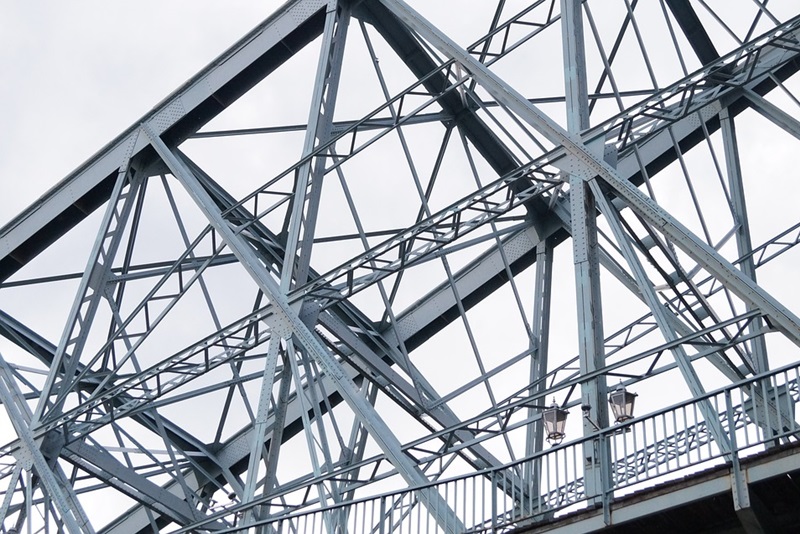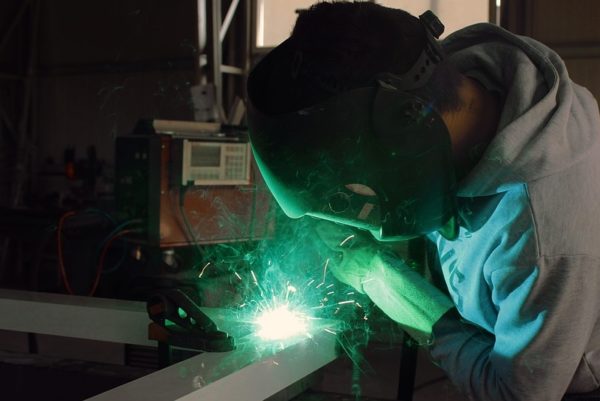Before we find out what is fabrication in industrial terms, let’s understand the literal meaning of fabrication explained in the oxford dictionary. Fabrication is “the action or process of inventing or manufacturing something”.
In industrial terms, fabrication is the process of taking raw material or stock which is converted in a part and is further used in the assembly process. In an assembly process, a series of operations are conducted and parts are added in sequence from workstation to workstation to produce the final product.

Steel Fabrication is a sensitive task because it needs skilled individuals who can handle the process well and work with care. It covers designing, detailing, drawing and constructing many steel structural members like deck, handrails, stairs and a lot more. Steel is used for constructing bridges, residential buildings, etc. Structural steel is useful for building complex and simple structures in a cost-effective and time-saving manner. A systematic well-designed steel fabrication process offers many benefits.
Fabrication Process:
Structural steel fabrication can be executed at the construction site or at a shop. This multifaceted process requires skills, expertise and resources to complete the job successfully. The method followed on-site is similar to what is performed in a shop but it’s the work quality, person who does the job, and equipment sophistication level that differs.
A good steel structural fabricator follows a specific process and the metal has to pass through many operations and a basic overview of the fabrication process steps are explained below:
- Firstly, structural sections may have to go through surface cleaning procedure so different cleaning methods need to be applied, like, blast cleaning, flame cleaning, manual cleaning, etc.
- Once the surface is prepared cutting to the length is important and it can be done by implementing the most suitable process like, shearing or cropping, flame cutting or burning, cold sawing, punching or drilling and arc plasma cutting
- After the above process the steel may get distorted because of handling or transportation process. Thus, it needs to be bended, rolled or straightened.
- Now fitting and reaming will come in picture. Minor defects will be corrected here.
- Now the use of fastening methods has to be proper as the strength of complete structure depends on it. The three fastening methods are riveting, bolting and welding. Nowadays welding is the most common method, but sometimes the need of bolting and riveting may arise.
- Then comes finishing. Finishing will be done by sawing, milling or any other suitable means. For satisfactory finished cuts, a saw machine is used and for smoothening the steel surface other methods are used accordingly.
- Lastly, the surface treatment is done with metal or paint coatings.

So, these are the basic steps involved in the fabrication process and there are many types of fabrication techniques where the most common ones are cutting and machining, punching and drilling, straightening, bending and rolling, fitting and reaming, fastening, finishing, etc.
A few types of fabrication techniques are listed below in detail:
- Cutting – For cutting there are numerous ways and it is done with the saw, plasma torches, water jets, and lasers.
- Machining – The process of machining involves removal of the piece of metal from a piece of material. It is performed either on lathe, where the material will rotate against a cutting tool, or in some other kind of cutting machine.
- Folding –Some parts require bending and with the help of a press brake which has a set of dies to pinch the metal, it is useful for forming a crease. This is performed in specific cases only.
- Shearing – To make a long cut on the piece of metal is known as shearing and it is performed on a sheet metal.
- Welding. To join two pieces of metal, welding is done. Various kinds of welding is performed on range of metals used for diverse applications.
In the fabrication process many types of fabrication materials are used. As fabrication process is quite complex the composition of materials which are being used need to have some desired proprieties. For example, strength, hardness, resistance to corrosion and conductivity are some of the basic properties required for the fabrication process. With the implementation of different techniques like, welding, bending and cutting, these materials are useful for variety of applications.

Features of these fabrication materials are stated below:
- Casting raw material – Casting is a fabrication process which is 6000 years old and in this method a liquid metal is forced into a mold which is then allowed to cool so it can harden in the required shape. For applications that need complex geometries it is an ideal method. Common metals used for casting are steel, magnesium, gold, silver, iron, copper, etc.
- Flat metal raw materials – Flat metal is a type of metal that has been rolled or pressed in thin or flat pieces. Thickness of a metal sheet varies greatly and is measured in gauges. Three general categories of flat metal raw materials are foil or leaf metal which is the thinnest type of flat metal, second one is sheet metal and the thickness of this metal is less than 6mm and the third one is plate metal which is thicker than 0.25 inches.
- Formed and expanded metal-The name expanded metal is derived from the process which is used for creating it. To create holes in diamond shape that are surrounded by interlinked metal strands a stock metal sheeting is first sheared in the press and then the shearing expands the metal to its final size. Expanded metal raw materials come in various grating sizes and standard thicknesses.
- Hardware raw materials – Hardware is defined as the many standardized parts or fittings which are useful to make a product strong, easier to fabricate and more functional. It includes basic raw materials like handles, locks, latches, chains, etc.
These are some of the basic fabrication materials used for end number of fabrication procedures. The uniform size and shape of these materials minimize the amount of fabrication which is vital to form a product. Moreover, standardized materials ensure structural integrity and quality during steel fabrication.

 by
by 


That seems like it’d really help for the fabricator to make sure that the surface will be clean whenever they work on structural sections. I’d imagine that steel fabrication would help to make buildings and things like that stronger. It’d also make them look more modern. If you were making a structure, then you’d probably do good to find a steel fabricator who’d know how to properly do it.
Thanks for the comment and your input.Yes,it is always important to use professionals in the industry for design and fabricating structural steel.
There are many different types of sheet metal fabrication available in metal industries. I agree with that, fabrication is the action or process of inventing or manufacturing something. Thank you for sharing this information in a straight forward and easy to understand manner. I deeply appreciate it.
I know that the steel fabrication is passing through a detailed and structured process. I just also want to make sure that the company is after the welfare of those that are working in this industry, to avoid an accident. Nevertheless, the fabrication techniques are quite advanced.
I had no idea that machining involved removing pieces of metal. Steel fabricating seems like a fascinating process. It sounds complicated too, so I’m sure you’d want to hire a professional for that.
True,Steel Fabrication should be done by professionals…
It is good to know more about the different types of steel fabrication techniques such as welding, which is done to join two pieces of metal together. I never knew that steel fabrication involves numerous process, and I believe that all of these are necessary so that one can exactly produce the part that is needed for a machine. Thanks for this information about the different types of steel fabrication techniques and how each of these are done.
I find the information that you talked about with folding to be very interesting. When it comes to fabrication techniques, I like to look into different ideas and methods that may help with my metal projects. Thank you for your information on steel fabrication.
You got my attention when you said that welding is a type of fabrication technique that works to join 2 pieces of metal together and can be used on a range of metals. My husband said that he’s interested in finding a steel fabricator that he can talk to about his project for our house. I wanted him to know exactly what he needs from a steel fabricator, so I’ll make sure to share your blog with him.
I never knew that cleaning processes like blast cleaning and flame cleaning were involved in the first steps of the process. I was learning about steel fabrication in my engineering class last semester, and I guess they failed to mention that that was such an important part of the process. Thanks for laying everything out here so that I can understand even more about the fabrication process. I definitely learned some things, like the cleaning process, that I didn’t quite understand in my class!
Wow, I would have never guessed that there was so much to know about steel fabrication. However, I suppose you would want to know about the fabrication process before partnering your business with a steel manufacturer. That way you have an idea of how long the production of the steel will take.
I’m going to be taking a specialized shop course this semester, and learning some of these terms, like machining and folding, has really helped me feel more prepared. Metal fabrication is going to be a large unit in the course I’m taking, and going in, I didn’t even know about hardware raw materials and the inclusion of basic raw materials like locks and latches within the category. I think I’ll share some of this with my classmates when we’re going over the basics; I’m sure we’ll all need to know the necessary desired qualities, like hardness and resistance, before we take our first quiz, let alone our first lab.
Glad this article about Steel Fabrication is helpful.
Awsome article
It sure got my attention when you said that using steel construction in the building would help reduce the environmental impacts because they are durable, are easily manufactured and fabricated, and could last a long time. This surely is a helpful bit of information to consider for architects and engineers in their respective design and practice in the industry in order to reduce and minimize the environmental impacts of construction. I’ll be sure to mention this to my friends who are planning on entering the construction industry so they’ll be aware of the benefits of using steel fabrication in their designs.
Thank you for sharing very positive information. It is useful for knowledge for us. it’s helpful for understanding the work of steel fabrication work. I also share the information related to the Top steel fabrication work in Nagpur.